Mayan Calendar Facts
We humans have been predicting our own demise as far back as the Roman Empire, when the Romans feared their city would fall into ruin in 634 BCE.
Christopher Columbus determined that the apocalypse would occur in 1658, while the self-appointed prophet/poet Nostradamus predicted that it would take place in the seventh month of 1999.
Even acclaimed scientist Isaac Newton put some thought into the matter, studying the Bible and concluding that our time would not run out until sometime after the year 2060.
One of the most recent predictions about the end of Earth is due to culminate on Dec. 21, 2012, when the 13th B’ak’tun of the ancient Maya calendar concludes. Despite the theory’s persistence, it’s unlikely that the Maya believed that the world would end on that day.
Scientists do agree that we are at risk from a number of less fantastical factors and that Earth does have an expiration date — but it’s a billion years away.
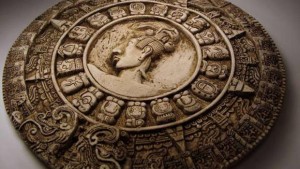 During excavations in spring 2012 in the Maya city of La Corona in Guatemala, American archaeologists came across a battered stairway block that had been left behind by grave robbers. When scientists at University in New Orleans took a closer look at the barely perceptible inscriptions, they found a date: Dec. 21,2012.
During excavations in spring 2012 in the Maya city of La Corona in Guatemala, American archaeologists came across a battered stairway block that had been left behind by grave robbers. When scientists at University in New Orleans took a closer look at the barely perceptible inscriptions, they found a date: Dec. 21,2012.
Doomsday prophets had already marked this date — the end of the longest cycle of the Maya calendar — as the one on which life as we know it would come to an end. The discovery of the 1,300-year-old Guatemalan block seemed to bolster their claims, as it contains the second known reference to Dec. 21. (The first was identified in Mexico in 2004.)
But even though the date of our supposed day of reckoning is based on the archaeological record, the predictions themselves aren’t: None of the inscriptions are intended to be read as prophecies; they refer to ancient gods and kings.
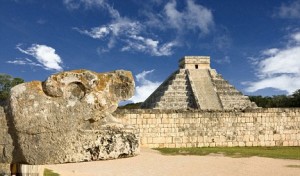 Dec. 21, 2012, was a meaningful date for the Maya, however. It is the final day of the long count, the numerical system the Maya used for keeping track of long periods of time. The calendar began with a mythical creation on Aug. 11,3114 BCE, and its longest cycle, the B’ak’tun, lasted for 144,000 days (just over 394 years). When our calendar reaches Dec. 21,13 of these long periods — some 5,125 years — will have passed.
Dec. 21, 2012, was a meaningful date for the Maya, however. It is the final day of the long count, the numerical system the Maya used for keeping track of long periods of time. The calendar began with a mythical creation on Aug. 11,3114 BCE, and its longest cycle, the B’ak’tun, lasted for 144,000 days (just over 394 years). When our calendar reaches Dec. 21,13 of these long periods — some 5,125 years — will have passed.
Our world will be replaced in 2012
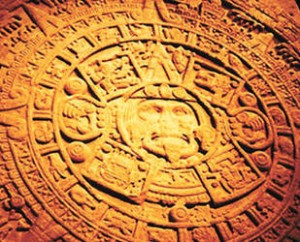 The 13 B’ak’tun are central to the Maya creation myth. Our present world, which is fourth in the sequence, began after the previous cycle of 13 B’ak’tun, leading some to believe that our world will end when the next cycle begins, in 2012.
The 13 B’ak’tun are central to the Maya creation myth. Our present world, which is fourth in the sequence, began after the previous cycle of 13 B’ak’tun, leading some to believe that our world will end when the next cycle begins, in 2012.
But no Maya texts claimed that the world would perish after 13 B’ak’tun. Scientists think that the Maya would simply have continued with a 14th B’ak’tun or, if their system only allowed for a cycle of 13 B’ak’tun, they would have just started the calendar over again — not unlike our system of beginning each new millennium with the year “01” on Jan. 1.
In either case, experts think that the Maya would have celebrated the event like we do New Year’s Eve. Also like us, the Maya were optimistic about their civilization’s longevity: King Pakal was confident that an anniversary marking his accession to the throne in the 600s would still be celebrated in 4772.
![Ancient mayan people Ancient mayan people]() The ancient Maya were capable astronomers
The ancient Maya were capable astronomers
The Mayas’understanding of astronomy has lent credence to the myth that the end of their calendar meant the end of our world: If they knew the sun’s path across the sky during the year, the phases of the moon and the movements of the visible planets, perhaps they saw something in the stars predicting our end.
Our knowledge of Maya astronomy largely comes from the Dresden Codex, a well-preserved folding book made of fig tree bark that dates to the 11 th or 12th century. Named after the German city in which it is housed, it contains tables of future solar eclipses and calculations of Venus’future location in the sky.
The 10 greatest threats
Cataclysmic comet slams into the planet
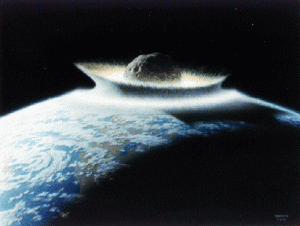 At first, it would appear as merely a speck in the sky, but an approaching comet heading directly toward Earth would soon roar into the inner solar system at a speed faster than 124,000 mph. Its impact would generate a tsunami several hundred feet tall and would kick up a massive cloud of water vapor, sulfur and dust into the stratosphere that would block sunlight and send temperatures plummeting across the globe.
At first, it would appear as merely a speck in the sky, but an approaching comet heading directly toward Earth would soon roar into the inner solar system at a speed faster than 124,000 mph. Its impact would generate a tsunami several hundred feet tall and would kick up a massive cloud of water vapor, sulfur and dust into the stratosphere that would block sunlight and send temperatures plummeting across the globe.
Scientists from Australia’s University of New South Wales think that this may have happened some 2Vi million years ago, when a comet a little more than a mile wide plunged into the Pacific between Chile and Antarctica. A comet — essentially a large, dirty snowball — builds great momentum in its oblong orbit around the sun, giving it tremendous speed. This means that we’d see it only weeks before impact — not soon enough to prepare for it.
Contagious disease kills millions
 A deadly disease that breaks out in a densely populated area or a global traffic hub could easily spread aggressively across the globe. Scientists feared this very scenario in 2003, when SARS (Severe Acute Respiratory Syndrome) appeared in southeast China. Up to 15 percent of infected people died, and only the swift medical response kept the death toll under 1,000 people. If doctors had reacted more slowly, millions may have died.
A deadly disease that breaks out in a densely populated area or a global traffic hub could easily spread aggressively across the globe. Scientists feared this very scenario in 2003, when SARS (Severe Acute Respiratory Syndrome) appeared in southeast China. Up to 15 percent of infected people died, and only the swift medical response kept the death toll under 1,000 people. If doctors had reacted more slowly, millions may have died.
Today, dangerous diseases such as ebola are spread only through direct contact with blood or other bodily fluids; thus the danger of infection is limited. But if ebola or a similar virus mutates to an airborne form, the situation could be much more dangerous. Such a mutation has not been observed in nature, but scientists won’t rule out that it could happen.
Earth explodes from below
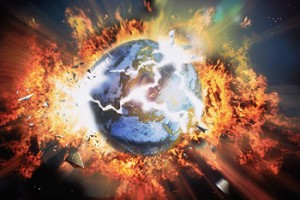 Buried underneath Yellowstone National Park, a 640,000-year-old crater measuring 45 x 34 miles shows the consequences of an exploding supervolcano.
Buried underneath Yellowstone National Park, a 640,000-year-old crater measuring 45 x 34 miles shows the consequences of an exploding supervolcano.
Lava spreading across the landscape would devastate vast tracts of land, and the surface of the Earth would collapse wherever the supporting magma erupted through the volcano. Ash ejected during the eruption would cover millions of square miles of farmland and could be up to a foot thick, even hundreds of miles from the blast. Very fine particles of ash carried into the atmosphere would obstruct sunlight, affecting the global climate for many years.
Gamma rays torch everything
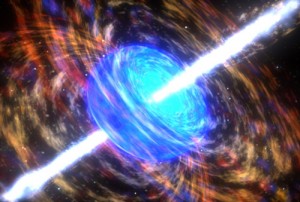 Just a 10-second burst of gamma radiation from a nearby hypernova would be enough to burn away half of Earth’s ozone layer. The globe would be bathed in harmful ultraviolet radiation, killing off large groups of organisms and devastating the food chain.
Just a 10-second burst of gamma radiation from a nearby hypernova would be enough to burn away half of Earth’s ozone layer. The globe would be bathed in harmful ultraviolet radiation, killing off large groups of organisms and devastating the food chain.
A hypernova is a giant star that suddenly explodes. In just seconds, it can emit as much energy as our sun will generate in its lifetime, along with deadly gamma rays. Luckily, such events are rare, and astronomers have yet to observe a gamma-ray burst in our galaxy.
Asteroid strike causes widespread destruction
The dinosaurs were likely pushed into extinction 65 million years ago when a large asteroid slammed into Earth — and the same fate could await us.
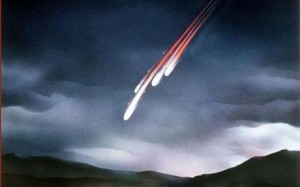 There are thousands of asteroids orbiting the sun, but, unlike comets, they move so slowly that astronomers can observe them and keep track of potential collisions.
There are thousands of asteroids orbiting the sun, but, unlike comets, they move so slowly that astronomers can observe them and keep track of potential collisions.
We are learning more about asteroids all the time; NASA even trains astronauts to land on asteroids, just as the characters in the blockbuster film Armageddon did. Even so, experts don’t think we’re in any danger from a “dinosaur asteroid” for at least the next several hundred years. But even a smaller asteroid could cause destruction if it hits us at a speed of 37,000 mph.
If a rock even just a few miles wide were to strike, some 10 trillion tons of soil could be flung into the atmosphere. The dust cloud would block sunlight, causing temperatures to fall by about eight degrees. An asteroid impact in the ocean would generate a much bigger tsunami than the one in 2004 that killed 250,000 people.
Mars crashes into Earth
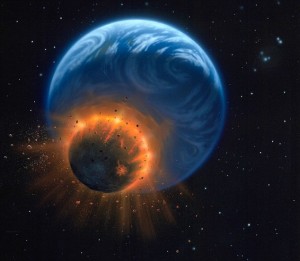 If Mars were to go off course and crash into Earth, all life on the planet would end. But if such a scenario does happen, it won’t be for another 3 billion years. Two French astrophysicists have calculated that the gravitational pull of the solar system’s largest planets may eventually destabilize the orbits of the inner planets, meaning that Earth could collide with Mercury, Mars or Venus. And, in fact, scientists think that just such an interplanetary collision created Earth’s moon some 4.5 billion years ago.
If Mars were to go off course and crash into Earth, all life on the planet would end. But if such a scenario does happen, it won’t be for another 3 billion years. Two French astrophysicists have calculated that the gravitational pull of the solar system’s largest planets may eventually destabilize the orbits of the inner planets, meaning that Earth could collide with Mercury, Mars or Venus. And, in fact, scientists think that just such an interplanetary collision created Earth’s moon some 4.5 billion years ago.
Smart robots overtake us
Not only has the processing power of computers increased exponentially since their invention, but we’re now creating robots that can learn independently — it’s just a matter of time before they gain full artificial intelligence. And these smart robots could quickly outcompete humans. In his book The Singularity Is Near, futurologist Ray Kurzweil predicts that we’ll be outdistanced sometime around 2045. If he’s right, our future is indeed uncertain.
Nuclear war kills billions
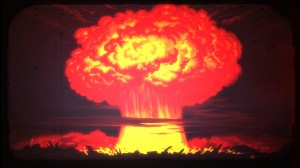 The majority of the world’s 19,000 nuclear weapons are located in the United States and Russia. If the two countries ever use them, three quarters of a billion people would die immediately. The rest of the world would be hard-pressed to survive the aftermath, as the massive explosions and subsequent fires would send hundreds of millions of tons of soot into the atmosphere, resulting in a long nuclear winter.
The majority of the world’s 19,000 nuclear weapons are located in the United States and Russia. If the two countries ever use them, three quarters of a billion people would die immediately. The rest of the world would be hard-pressed to survive the aftermath, as the massive explosions and subsequent fires would send hundreds of millions of tons of soot into the atmosphere, resulting in a long nuclear winter.
Deadly synthetic diseases escape the lab
In 2011, scientists from the Netherlands and the United States created airborne versions of the “bird flu” virus, making an already-serious disease even more so. If it had escaped the lab, the infectious agent could have spread to millions of people before a vaccine could be developed. Other deadly, highly contagious diseases such as smallpox could fall into the hands of warring nations or terrorists.
Nanorobots run amok
Tiny nanorobots could soon be designed to clean up the pollution left by oil spills. But a simple programming error could cause them to consume, in addition to oil, other types of carbon-based, organic material, placing all life on Earth in danger. If the robots learned to replicate themselves, the risks would be even greater.

